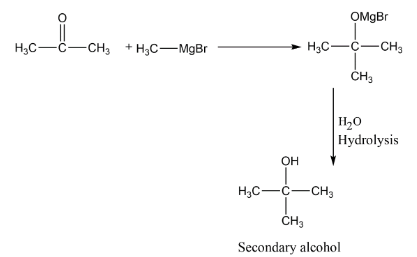
Give the structure and IUPAC names of the products expected from the following reaction:
A. Catalytic reduction of butanal.
B. Hydration of propene in the presence of dilute sulphuric acid.
C. Reaction of propanone with methylmagnesium bromide followed by hydrolysis.
Answer
456k+ views
Hint: Try to write the process according to the chemical reaction happening in the presence of that reagent, there are some oxidizing agents which oxidize the group and also there are some reducing agents. The most commonly used reagent for reduction is hydrogen with nickel, nickel is the catalyst there. Always remember that on reduction of aldehyde we will get alcohol.
Complete step-by-step answer:
A. Catalytic reduction is the reduction in which reduction is taking place but in presence of some catalysis. We have butanal which is an aldehyde, for reduction we are using hydrogen in the presence of nickel metal

B. Next we have propene, it means we have a three carbon compound with a double bond it is an unsaturated hydrocarbon. Now we have to do the hydrolysis of propene in the presence of dilute sulphuric acid

C. We have Grignard reagent as methylmagnesium bromide

Note: In option C, during hydrolysis the bond between oxygen and magnesium will cleave such that oxygen will get hydrogen and magnesium will get from water molecules on hydrolysis. In option B, when hydrolysis of propene happens, it will occur according to the Markonikov rule of addition while in some reactions, addition also takes place according to Anti-Markovnikov rule when presence of peroxide will be given.
Complete step-by-step answer:
A. Catalytic reduction is the reduction in which reduction is taking place but in presence of some catalysis. We have butanal which is an aldehyde, for reduction we are using hydrogen in the presence of nickel metal

B. Next we have propene, it means we have a three carbon compound with a double bond it is an unsaturated hydrocarbon. Now we have to do the hydrolysis of propene in the presence of dilute sulphuric acid

C. We have Grignard reagent as methylmagnesium bromide

Note: In option C, during hydrolysis the bond between oxygen and magnesium will cleave such that oxygen will get hydrogen and magnesium will get from water molecules on hydrolysis. In option B, when hydrolysis of propene happens, it will occur according to the Markonikov rule of addition while in some reactions, addition also takes place according to Anti-Markovnikov rule when presence of peroxide will be given.
Latest Vedantu courses for you
Grade 9 | CBSE | SCHOOL | English
Vedantu 9 CBSE Pro Course - (2025-26)
School Full course for CBSE students
₹37,300 per year
Recently Updated Pages
Master Class 11 Economics: Engaging Questions & Answers for Success

Master Class 11 Business Studies: Engaging Questions & Answers for Success

Master Class 11 Accountancy: Engaging Questions & Answers for Success

Master Class 11 English: Engaging Questions & Answers for Success

Master Class 11 Computer Science: Engaging Questions & Answers for Success

Master Class 11 Maths: Engaging Questions & Answers for Success

Trending doubts
State and prove Bernoullis theorem class 11 physics CBSE

1 ton equals to A 100 kg B 1000 kg C 10 kg D 10000 class 11 physics CBSE

State the laws of reflection of light

One Metric ton is equal to kg A 10000 B 1000 C 100 class 11 physics CBSE

Difference Between Prokaryotic Cells and Eukaryotic Cells

1 Quintal is equal to a 110 kg b 10 kg c 100kg d 1000 class 11 physics CBSE




